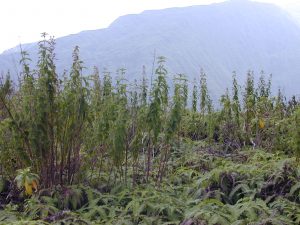THE TARGET: Tibouchina herbacea & Other Related Melastomes
Tibouchina herbacea is considered the primary target for the release of Syphraea uberabensis, however, the agent has the potential to impact other related weeds such as Tibouchina urvilleana, Tibouchina longifolia, Pterolepis glomerata, Melastoma septemnervium, and Melastoma sanguineum.
- Tibouchina herbacea is a noxious weed that invades disturbed wet and mesic forests and shaded areas by forming dense stands and out-competing native species. It spreads vegetatively and by prolific production of tiny seeds. Because of its wide distribution and ability to invade remote areas, the use of chemical and mechanical controls is economically prohibitive for controlling advanced infestations, therefore biocontrol is considered the only sustainable control method at the landscape level.
- Distribution: Tibouchina herbacea is naturalized and locally abundant in disturbed mesic to wet forests on the islands of Hawaiʻi, Lānaʻi, Maui, Molokaʻi, and Oʻahu. It is native to Southern Brazil, Uraguay, and Paraguay.
THE CANDIDATE: Syphraea uberabensis
-
Syphraea uberabensis is a small Brazilian beetle and natural herbivore of T. herbacea. Adults and larvae feed externally on foliage and soft stems of T. herbacea, reducing plant growth and causing enough damage to kill small plants.
Native range: Native to Brazil. Its distributional range is not well studied.
Host testing results: Host specificity of S. uberabensis has been tested on a wide variety of native and non-native plants in both Brazil and Hawaiʻi. Results of the studies indicate that S. uberabensis does not have the capacity to colonize native or economic plants in Hawaiʻi, and the host range is limited to T. herbacea and other melastomes within the tribe Melastomae, including Tibouchina urvilleana, Tibouchina longifolia, Pterolepis glomerata, Melastoma septemnervium, and Melastoma sanguineum. All Tibouchina and Melastoma species are listed as noxious weeds in the state, and P. glomerata has invaded native habitats and been targeted for eradication or control in conservation areas.
Timeline of project progress:
- Final Environmental Assessment – Published in the State of Hawaiʻi Environmental Review Program (ERP) The Environmental Notice on September 23, 2022.
- Awaiting permits from Hawaiʻi Department of Agriculture & import into Hawaiʻi prior to release.

